Key Insights
- Funko’s licensed Back to the Future collection led WAX collections with over $1 million in total Q4 sales volume. As a whole, WAX’s average daily NFT volume decreased by 32% QoQ to $54,000.
- WAX Labs announced $WAX tokenomics updates planned for Q1’24. An optional gas fee will be introduced to augment staking for network resources. The network will stop collecting a 2% fee on NFT volume and bridging fees to Ethereum for liquidity rewards.
- WAX’s stablecoin market cap increased by 823% QoQ to $243,000. The growth was largely driven by USDT bridged by Alcor Exchange from EOS via Antelope IBC.
- $WAX’s circulating market cap grew by 67% QoQ to $236 million, ranking it 187th among all tokens
- A reduction in the amount of network resources available for free caused onchain activity to decrease. Average daily active transactions and addresses fell QoQ by 51% and 25%, respectively.
Primer
Worldwide Asset eXchange (WAX) is a Layer-1 (L1) network geared toward gaming and NFT use cases. WAX launched in June 2019 following a token generation event (TGE) that raised around $60 million at the end of 2017. The network is built using the open-source Antelope framework (formerly EOSIO), which features Delegated Proof-of-Stake consensus, smart contract programming in C++, a unique resource model with bandwidth and state storage components, and a smart contract accounts model with similar effects to account abstraction. On top of this core Antelope stack, WAX Labs built other services, including a cloud-based wallet, an NFT creator and marketplace, an onchain random number generator, and a block explorer. These services were built to provide a more familiar Web2 experience on top of the core blockchain protocol. For a full primer on WAX, refer to our Initiation of Coverage report.
Website / X (Twitter) / Discord
Key Metrics
Financial Overview
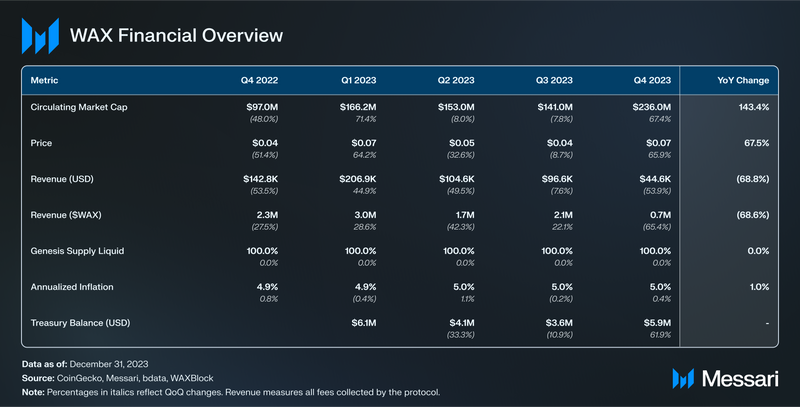
As a whole, the crypto market rebounded in Q4’23. $WAX was no exception – its circulating market cap increased 67% QoQ to $236 million. However, $WAX was outpaced by other tokens, as its market cap rank fell from 160th to 187th QoQ.
WAX’s onchain activity did not follow the market trend in Q4. After an increase last quarter, total quarterly revenue in $WAX decreased 54% QoQ to 0.7 million ($45,000).
WAX has a unique resource model where $WAX ($WAX on the WAX network, $WAXP on the Ethereum network) can often be recouped by the user if they no longer require bandwidth or state storage resources. Thus, WAX does not collect fees through gas fees like many other networks.
The existing system functions as such:
- WAX’s revenue comes from a 2% tax on NFT secondary sales backed by a “gentlemen’s agreement” with NFT marketplaces.
- WAX burns 20% of this revenue and bridges the remaining 80% to Ethereum to distribute to liquidity providers (see the DeFi section for more details).
- The WAX protocol mints $WAX at a 5% annual inflation rate which it distributes to validators (2%), delegators (2%), and its treasury (1%).
However, WAX’s fee collection system and general tokenomics are set to change in Q1 2024.
Under the new system:
- WAX will no longer collect a 2% tax on NFT secondary sales and will discontinue the Ethereum DeFi rewards system. Instead, fees will come from a new PowerUp mechanism, which will function more similarly to traditional transaction gas fees. In order to currently transact, users need to reserve network bandwidth by staking $WAX. With PowerUp, users will be able to also just pay a small $WAX fee per transaction if they don’t have any bandwidth. A similar PowerUp resource model was adopted by EOS in early 2021; however, EOS discontinued staking for bandwidth, relying entirely on PowerUp, whereas WAX will keep it and offer PowerUp as an additional option.
- The WAX protocol will continue distributing $WAX to validators, delegators, and its treasury at an equivalent rate of 5% network inflation. The relative distribution to each bucket also remains the same. Rather than minting new tokens for rewards and then burning fees, fees will replace minted tokens as rewards. Any fees exceeding the equivalent of 5% network inflation will be burned.
Although there is a slight technical difference, the overall inflation rate follows the same logic as before: it starts at 5% and any fees burned reduce the overall rate. The major difference is that fees are now collected from an optional gas fee instead of a tax on NFT volume. Furthermore, all fees go towards reducing inflation, whereas before only 20% of fees were burned, with the other 80% being used as liquidity rewards for $WAX pools on Ethereum.
The new tokenomics system is planned to go live in Q1, and it will be continuously evaluated for further optimizations in future quarters.
Network Overview
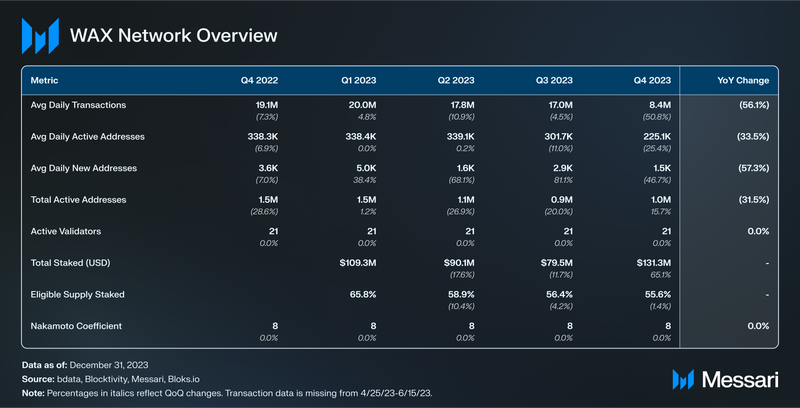
Usage
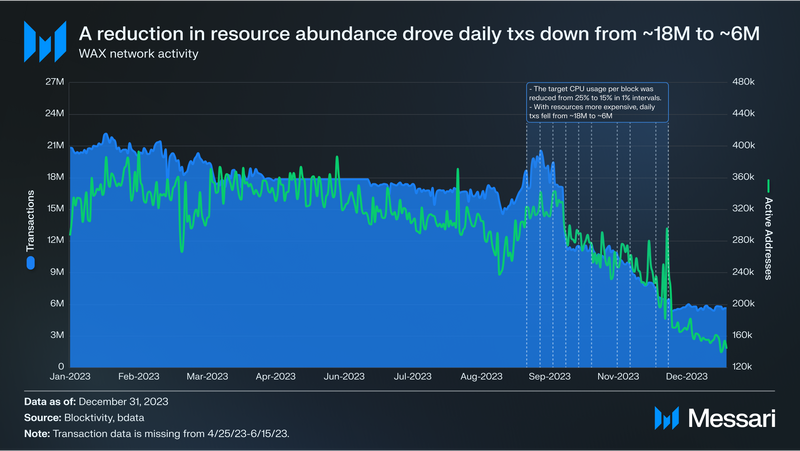
In preparation for the PowerUp implementation in Q1 2024, WAX developers made some resource adjustments, which led to a reduction in onchain activity. As noted, users need to reserve network bandwidth by staking $WAX in order to transact. Network bandwidth is represented by NET, a space-denominated resource that measures WAX’s throughput capacity in bytes, and CPU, a time-denominated resource that measures the processing time of a transaction in microseconds. Both NET and CPU are regenerable resources that users receive proportional to their share of stake.
From September 11 to November 28, the parameter controlling the target CPU usage per block was reduced from 25% to 15% in 10 different 1% intervals. With less bandwidth available per block, the resource became relatively more expensive.
As a result, daily transactions decreased from around 18 million to 6 million. As a whole, average daily transactions fell by 51% QoQ to 8.4 million. However, average daily active addresses fell by less: down 25% to 225,000.
The higher drop in transactions relative to addresses indicates that the increase in resource cost mostly affected high-transacting addresses. As detailed in the Popular Contracts section below, these inactive power addresses were mostly related to P2E games.
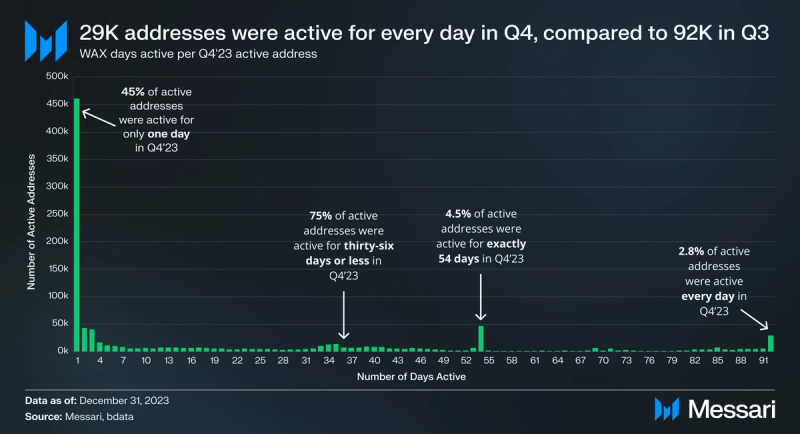
Indeed, Q4 active addresses tended to be active for fewer days in Q4 than Q3 active addresses were in Q3. In Q4, there was a total of over 1 million unique active addresses, a 16% QoQ increase. However, 45% of these addresses were active for only one day in the quarter, compared to 14% in Q3. Furthermore, 2.8% of addresses (29,000) were active every day in Q4, compared to 10% (92,000) in Q3. There was also an anomalous 4.5% of Q4 active addresses active for exactly 54 days in the quarter. There were 58 days from the start of the quarter to the last reduction in the target CPU available on November 28. Thus, the addresses active for exactly 54 days in the quarter were likely power addresses that stopped transacting due to the resource changes.
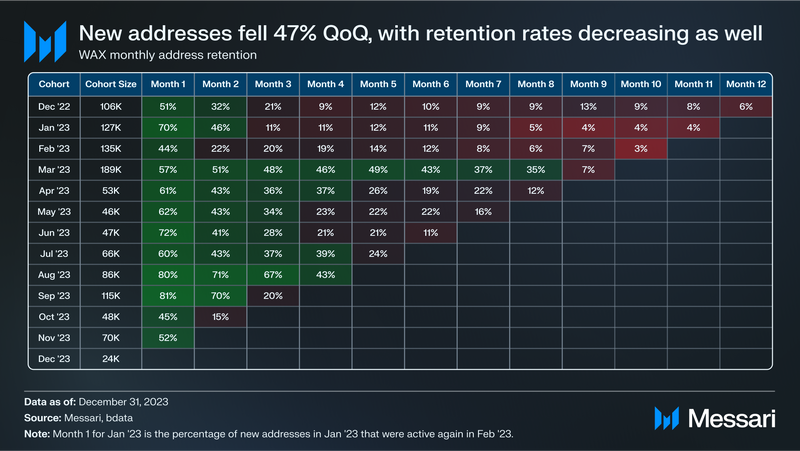
After an 81% increase last quarter, average daily new addresses fell 47% QoQ to 1,500. Retention rates also dropped. The October and November cohorts of new addresses had an average one-month retention rate of 49%, compared to 65% on average from the January to September cohorts.
Security and Decentralization
At the end of the quarter, there were 69 validators with WAX voting power; however, only the top 21 with the most voting power can participate in consensus in a given round. Staked $WAX decreased 0.5% QoQ to 1.9 billion $WAX. However, with $WAX’s price appreciation, staked $WAX denominated in USD increased 65% QoQ to $131 million. Not all of these staked tokens are necessarily delegated to validators, though; they could just be staked in WAX’s resource model and not used for voting for validators.
In WAX’s Delegated Proof-of-Stake (DPoS) model, a tokenholder does not delegate tokens toward one validator; instead, they stake their tokens and then can vote for up to 30 validators. Each validator would then receive that tokenholder’s full amount as voting power. For example, if a tokenholder has 1 million voting power and votes for 30 validators, each validator would have 1 million voting power. Due to this system, it is impossible to precisely measure how much stake is delegated to all validators versus the top 21 (participating validators).
Geographic diversity is an important factor in the resiliency of a validator network. Of the participating validators at the end of the quarter, Europe was the most popular hosting region with nine validators.
Upgrades and Roadmap
Near the end of the year, WAX Labs published its 2024 roadmap. Beyond the tokenomics update, key features planned for Q4 include:
- Antelope Leap 5.0 Upgrade (est. Q2 2024): The Antelope Leap protocol powering WAX (along with other networks including EOS, UX Network, and Telos) upgraded to version 5.0 in early October. The Leap 5 upgrade brought several notable features, including relaxed constraints allowing for larger transactions, sync latency optimization, node memory and multithreading improvements, and a new method for managing state memory. WAX plans to update to Antelope Leap 5.0 in Q2 2024.
- Antelope Instant Finality (est. Q4 2024): The Antelope Instant Finality feature was initially planned to be included in the 5.0 upgrade but was postponed to Leap 6.0. The Instant Finality upgrade will implement a modified variant of HotStuff, a BFT-based protocol developed by VMware. The upgrade will bring several improvements to the WAX network including expanding the validator count beyond 21 and bringing near-instant finality, discussed in more detail in the Q3 report. WAX Labs estimates that the WAX network will feature Instant Finality in Q4 2024.
- WAX Side Chain Launchers (est. Q2-Q3 2024): WAX developers are working on a framework that enables developers to launch sidechains connected via Antelope IBC to WAX and other Antelope networks. WAX Labs anticipates this feature will be ready in Q2 2024. There is also an EVM Side Chain Launcher planned for Q3 2024, which will enable EVM developers to more easily participate in the WAX ecosystem.
- Cloud Wallet Updates: WAX Labs is planning several updates to the Cloud Wallet throughout 2024, including a mobile app for iOS and Android, Unity SDK 2.0, social features, and further optimizations. In Q4, Wallet Connect support was introduced into the Cloud Wallet.
Ecosystem Overview
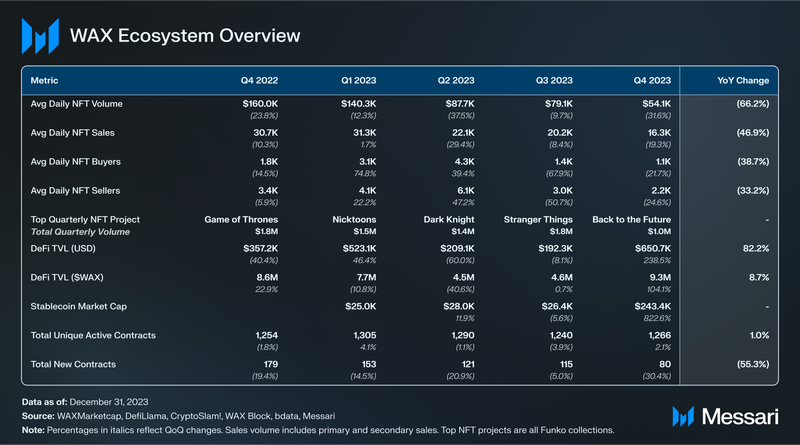
Popular Contracts
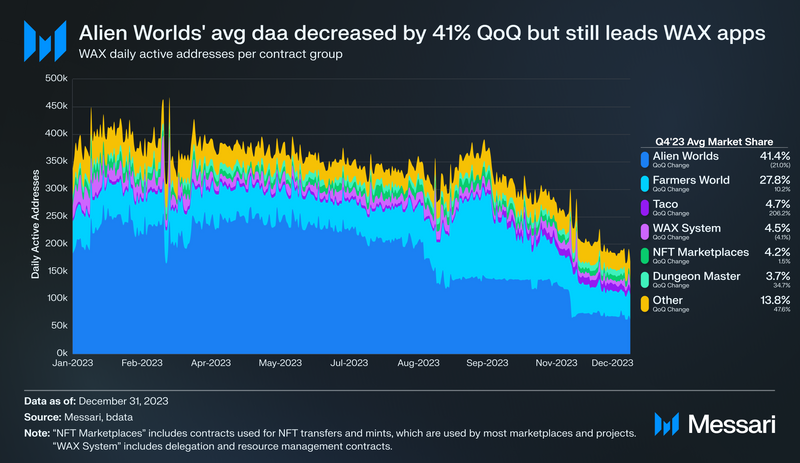
Play-to-Earn (P2E) games Alien Worlds and Farmers World account for the majority share of WAX daily active addresses among contract groups. From November 21 to 23, Alien Worlds’ daily active addresses fell from 115,000 to 66,000, where it remained for the rest of the quarter.
Although Farmers World’s average daily active addresses decreased by 17% QoQ, its market share increased by 10% due to Alien Worlds’ decrease. Farmers World continues to see notable activity despite the team selling the entire treasury (worth around $50 million at the time) and halting all development and communication almost two years ago.
Taco is a platform featuring several P2E games, including Acryptia and Brigade, as well as a DEX, an NFT marketplace, and more. Its average daily active addresses increased by 130% QoQ to 12,000. Its market share among WAX contract groups grew by 206% to 4.7%.
The WAX System contract averaged 12,000 daily active addresses this quarter, down from 16,000 last quarter. It manages functions such as staking, delegation, and resource management.
Many NFT marketplaces and projects that conduct primary drops use the same set of contracts in their backend. We grouped these into the “NFT Marketplaces” bucket. As a group, these contracts averaged almost 11,000 daily active addresses this quarter, down 24% QoQ
Rounding out the top six was NFT-based game Dungeon Master, which averaged 9,000 daily active addresses in Q4.
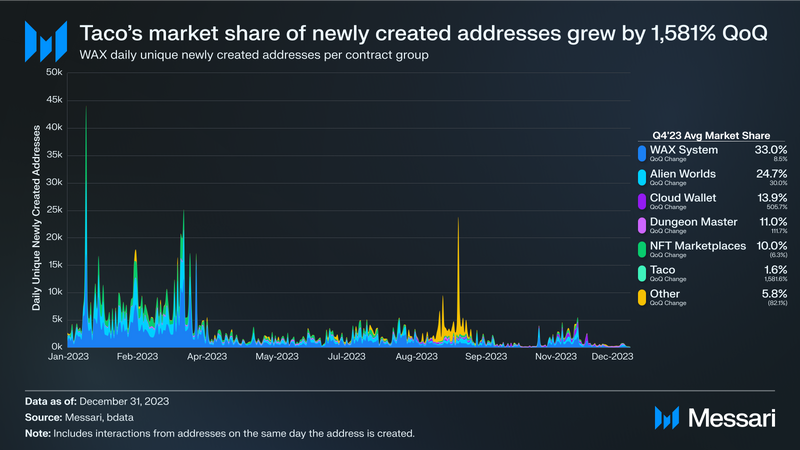
This chart includes only contract calls from addresses on the same day that the address is created (“newly created addresses”). It highlights what addresses are doing when they join the network, and the results offer several noticeable differences from the above analysis on contract calls from all addresses.
As expected with the decline in total new addresses, newly created addresses decreased for many WAX contract groups. The two exceptions in the top six contract groups were the Cloud Wallet Manager and Taco.
- As noted above, a Cloud Wallet update at the end of July enabled addresses to easily take control of their admin key. This Cloud Wallet Manager averaged 150 daily newly created addresses, a 122% QoQ increase. In total, over 15,000 Cloud Wallet addresses claimed control over their admin key in Q4.
- Taco’s average daily newly created addresses grew by 516% QoQ to 17. Its market share among WAX contract groups increased by almost 1,600% QoQ.
The “Other” group’s market share of newly created addresses fell by 82% QoQ to 5.8%, indicating that most new addresses are interacting with one of the top six contract groups.
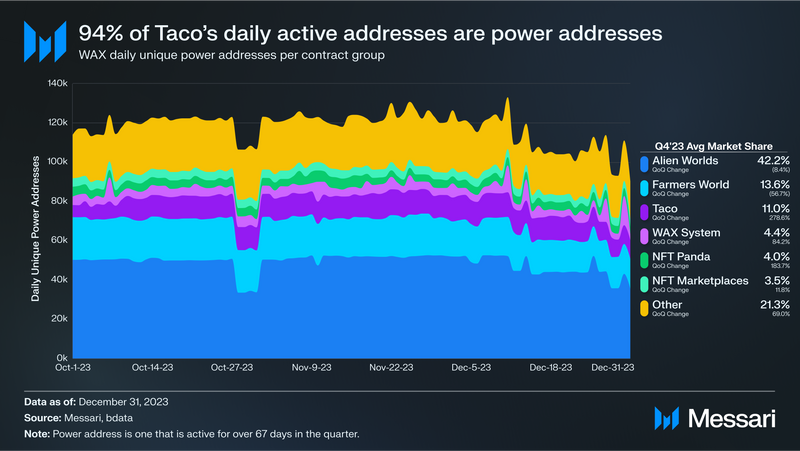
This chart again only looks at contract calls from a subset of addresses; here, power addresses. Power addresses are defined as addresses that were active for over 67 days in the quarter. Out of the over 1 million total active addresses in Q4’23, just over 100,000 were power addresses.
P2E games Alien Worlds, Farmers Worlds, and Taco led WAX contract groups in average daily power addresses on top of all addresses. Specifically, 46% of Alien Worlds’ daily active addresses were power addresses, 28% of Farmers World’s were power addresses, and 94% of Taco’s were power addresses. High-click Play-to-Earn games are prime for bot usage because they incentivize repeatedly clicking buttons. As such, the nature of these games could be accounting for the large number of power addresses for these dapps. It should be noted that bot activity occurs on many games and is not exclusive to WAX.
WAX Labs has been consciously working to reduce low-value bot activity. In June, WAX Labs integrated an AI/ML tool called TRUST into the WAX Cloud Wallet. Made by the NFT marketplace Chain Champs, TRUST analyzes an address’s transaction history and scores how likely it is to be a bot. TRUST scores are publicly available through the Cloud Wallet interface, on an API, and onchain through a smart contract. As a result, WAX dapps can use the scores within their own smart contracts to help track and prevent bot usage.
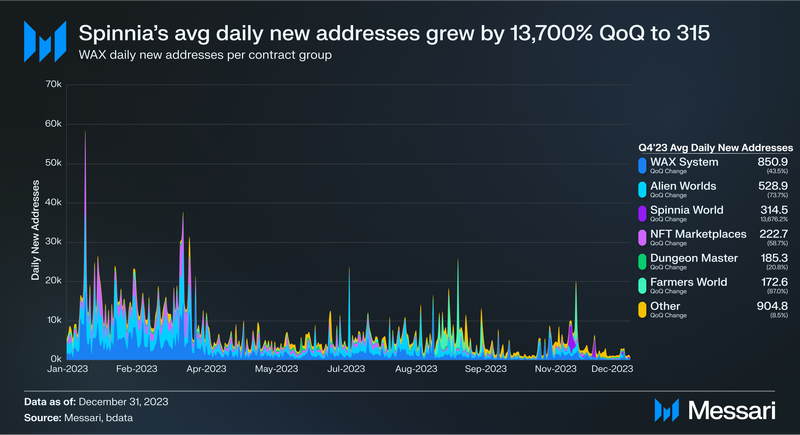
This chart re-examines all addresses (rather than just newly created or power addresses), but it only counts an address’s first interaction with a contract group. This analysis reveals the number of daily new addresses for each contract group.
Of the top six contract groups, Spinnia World, a spin-to-earn game, was the only one whose average daily new addresses increased QoQ. Its average daily new addresses grew by almost 14,000% QoQ to 314.
NFTs and Gaming
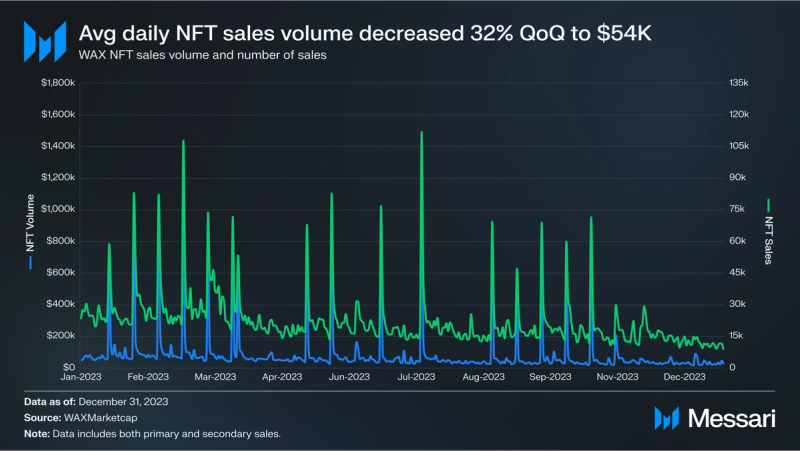
In the past quarter, WAX averaged $54,000 in daily NFT sales volume, a 32% QoQ decrease. Average daily sales decreased by less: down 19% QoQ to 16,000. The spikes in NFT volume and number of sales were driven by Funko drops, which are explored in more detail below.
According to CryptoSlam!, WAX ranked 15th among blockchains, excluding Bitcoin, in total Q4’23 NFT volume, compared to 12th last quarter. In the number of sales, it remained ranked 7th. It should be noted that CryptoSlam! only includes secondary sales data, unlike the above data which includes primary sales.
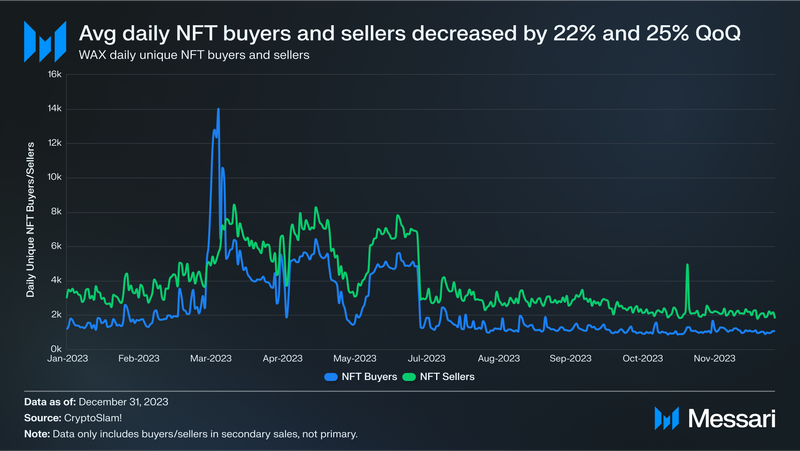
Average daily NFT buyers decreased by 22% QoQ to 1,100, and similarly, average daily NFT sellers decreased by 25% QoQ to 2,200.
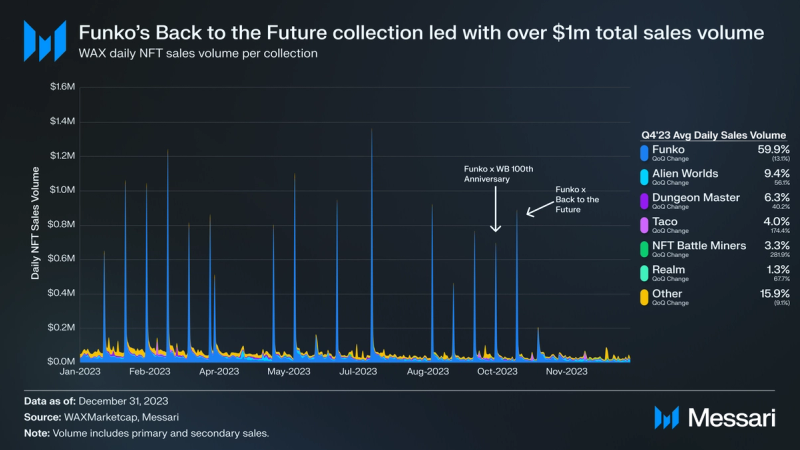
Funko collections averaged $32,000 in daily sales volume, 60% of total WAX NFT volume. Funko is a toy company that sells licensed pop culture collectibles. In Q3’21, it partnered with WAX to launch digital collectibles, some of which are redeemable for physical toys. Funko sells these digital collectibles in pack drops, which explains the significant spikes in WAX NFT sales volume. In Q4’23, Funko held five drops featuring licensed collectibles from WB 100th Anniversary, Back to the Future, Funkoween, The Powerpuff Girls, and Disney’s Mickey and Friends. Back to the Future was Funko’s most popular drop this quarter, with over $1 million in total Q4 sales volume.
Despite its decrease in active addresses this quarter, Alien Worlds’ average daily NFT sales volume increased by 7% QoQ to 5,100.
Dungeon Master is an NFT staking game on WAX and EOS created by gaming platform Wombat, which also features an in-house wallet. Its average daily NFT volume decreased by 4% QoQ to 3,400.
Last quarter, Wombat acquired AtomicHub, the most popular NFT marketplace on WAX by secondary sales volume. As noted above, WAX’s tokenomics are changing, including the removal of a 2% tax on NFT secondary sales backed by a “gentlemen’s agreement” with NFT marketplaces.
In its place, AtomicHub announced that it plans to add a 1% fee on secondary sales into its smart contracts. Its NFT standard smart contracts originally developed by Pink.gg are also used by other marketplaces including Nefty Blocks and NFTHive. Fees collected will be used to buy back and burn the native tokens of each marketplace (WOMBAT for AtomicHub, NEFTY for NeftyBlocks, and HONEY for NFTHive), as well as an ecosystem pool. AtomicHub also added template buy offers this quarter, which was soon after added by NeftyBlocks as well. Other NeftyBlocks updates from this quarter include NFT locking, a redesigned home page, and improved pack UX.
Rounding out the top six collections by Q4 sales volume were Taco, NFT Battle Miners, and Realm.
- After growing by 50% last quarter, Taco’s average daily NFT sales volume increased again by 88% QoQ to $2,200. Near the end of the quarter, Taco launched Season 5 of play-to-earn NFT game Acryptia.
- NFT Battle Miner’s average daily NFT sales volume grew by 161% QoQ to $1,800. NFT Battle Miners is an NFT-based PVP card game. It launched Season 3 of Shadow Depths in early December.
- Realm is a play-to-earn NFT game. Its Season 10 launched at the end of November.
Other NFT and gaming-related events include:
- BC Brawlers: In mid-October, BC Brawlers became available to play on the Epic Game Store. BC Brawlers is a PVP card game developed by WAX Labs that launched at the end of 2021. Soon after, WAX partnered with Amazon Prime Gaming to offer in-game perks to BC Brawlers players. In November and December, BC Brawlers offered Rounds 2 and 3 of gaming loot through Prime Gaming. Despite the exciting partnerships, BC Brawlers’ average daily NFT collection continued to see declined volume, down to $61 in Q4.
- B’Ape Beats Festival: In mid-December, WAX Ape Rave Club dropped a new 10k PFP project, WAX B’Apes, which sold out. Holders could then participate in the crafting event, competing to create the rarest NFT. NFT collections launched by WAX Ape Rave Club averaged $616 in average daily Q4 sales volume.
- Uncut Partnership: In mid-October, WAX Labs announced a partnership with Uncut, an NFT-powered social network on WAX. The partnership will directly integrate Uncut with the Cloud Wallet. To celebrate the partnership, users who connected their wallet to Uncut received a Barbarians NFT.
- And even more, including the WAX Bee Crafting Event, Music Mogul Showdown, representation at MCM Comic Con, the XMas Game Fest, and FGL NFT’s Masters of Mechaworld.
DeFi
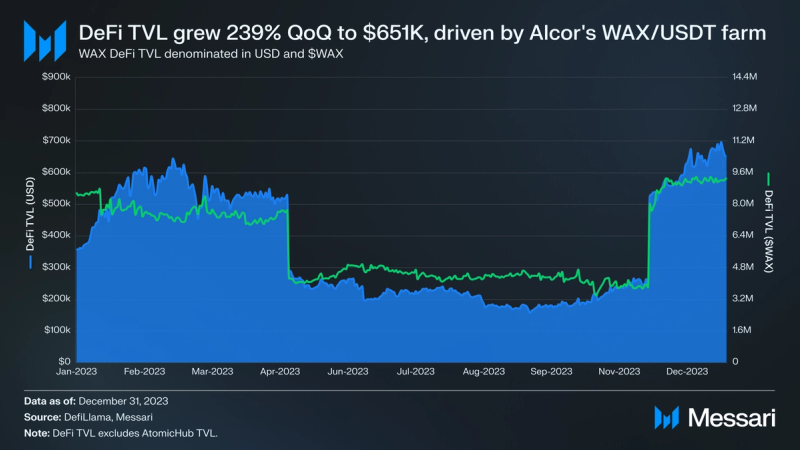
DeFi TVL in USD increased 239% QoQ to $651,000, ranking WAX 160th among all chains. Denominated in $WAX, DeFi TVL grew by 104% QoQ, indicating that the USD TVL growth was not only due to $WAX’s price appreciation.
The increase in TVL largely came from a spike in Alcor Exchange deposits in mid-November. In mid-October, Alcor Exchange introduced farming rewards for its WAX/USDT pool, with 180,000 $WAX to be distributed over a 90-day period. The USDT is bridged from EOS via Antelope IBC. Antelope IBC is an inter-blockchain protocol developed by UX Network core development team 0rigin, with funding from the Antelope Coalition (the collection of teams from WAX, EOS, UX Network, and Telos). In Q2, WAX integrated Antelope IBC into the network, connecting it with all the other Antelope networks.
Previously, the only stablecoins on WAX were brought over from Ethereum by WAX Labs via a two-of-four multisig bridge (consisting of WAX’s president, COO, CTO, and blockchain lead). USDT on EOS is a native integration, and the IBC bridge does not introduce further trust assumptions beyond the validator set of each network. Thus, USDT bridged via Antelope IBC from EOS provides a more secure stablecoin option.
Largely driven by Alcor’s bridging of EOS USDT, WAX’s stablecoin market cap increased by 823% QoQ to $243,000.
Under the new WAX tokenomics system, fees will no longer be bridged to Ethereum to distribute to liquidity providers in a WAX-ETH Uniswap V2 pool. While there’s still over $4.8 million in the pool, there will no longer be additional liquidity rewards from WAX fees. The final WAX DeFi epoch concluded in late December. In total, 54.3 million $WAX was burned via the WAX DeFi system ($3.8 million based on $WAX’s price at the end of Q4).
Development and Growth
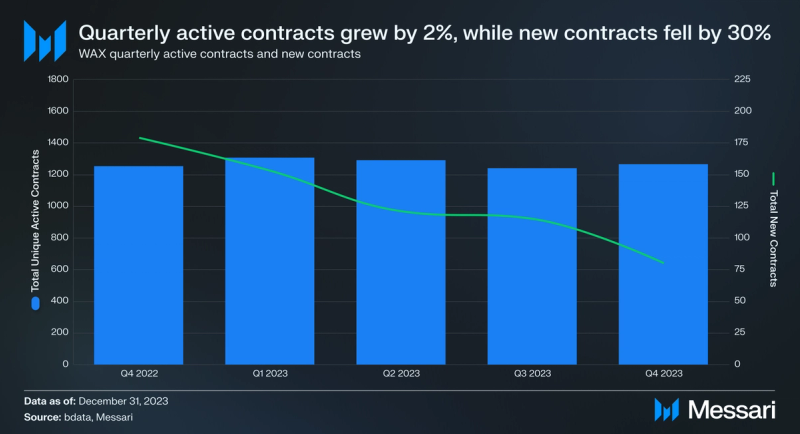
While the number of total unique active contracts called remained steady in the past year, new contracts continued to decline. Total active contracts increased by 2% QoQ to 1,300. Meanwhile, new contracts fell 30% QoQ to 80. The network will continue tapping into its treasury to incentivize new builders on WAX. Its treasury currently stands at $5.9 million and is projected to grow at a yearly rate of $2.4 million, based on current prices from its allocation of 1% network inflation.
In mid-November, Greymass released developer toolkit Wharf 1.0 to streamline development on Antelope-based blockchains. Wharf 1.0 brought an update to the Session Kit and launches of the Contract Kit and Account Kit.
- The Session Kit allows developers to easily enable users to connect to a web app with their wallet, establish a session on the blockchain, and other features. Its V1.0 launched in early August.
- The Contract Kit helps developers interact with smart contracts, reading and writing the data they need. It also features a Command Line tool which helps developers automatically generate code to build applications.
- The Account Kit provides APIs for developers to query information about Antelope user accounts. It also includes tools for resource management, including the ability to abstract away resource management from end users.
Beyond the Wharfkit, Wharf 1.0 also includes core Antelope libraries, plugins, APIs, and utilities.
WAX Labs plans to increase developer education through a Developer Guides Series in 2024. In Q1, the Tic Tac Token Series will provide a comprehensive guide to onchain game development, teaching developers how to use tools like WAX’s built-in Random Number Generator. In Q2, the Slide Puzzle Series will focus on blockchain state synchronization and integration architecture patterns.
Closing Summary
While $WAX’s market cap increased by 67% QoQ to $236 million, many other of WAX’s key metrics decreased QoQ. Onchain activity was lower in Q4, with average daily transactions dropping by 51% QoQ to 8.4 million and average daily active addresses falling by 25% QoQ to 225,000. The decreases were due to a reduction in the amount of network resources available for free. Average daily NFT activity also fell by 32% QoQ to $54,000.
On the other hand, WAX’s DeFi ecosystem picked up in Q4. Its DeFi TVL grew by 239% QoQ to $651,000. Growth was driven by Alcor Exchange’s WAX/USDT pool. Alcor facilitated the bridging of USDT from EOS via Antelope IBC. WAX’s stablecoin market cap increased by 823% QoQ to $243,000.
Near the end of the year, WAX Labs released its 2024 roadmap. Notably, $WAX tokenomics are set to change in Q1 2024. Fees will no longer come from a 2% tax on NFT secondary sales volume. Instead, the fees will come from a more traditional transaction gas fee model, with all fees burned. Other catalysts in 2024 include integrating new Antelope Leap upgrades and Cloud Wallet updates.
















